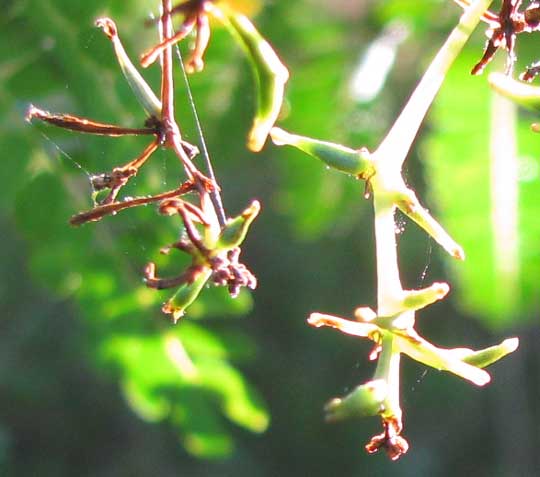Excerpts from Jim Conrad's
Naturalist Newsletter

from the November 28, 2010 Newsletter issued from Hacienda Chichen Resort beside Chichén Itzá Ruins, central Yucatán, MÉXICO; limestone bedrock, elevation ~39m (~128ft), ~N18.52°, ~W95.15°
WITCHES'-BROOM ON PHILODENDRON
Witches--brooms are those spiky clusters of stunted, deformed twigs you sometimes see on trees up North, especially oaks, hackberries, Honey Locust and junipers. Since they damage the plants they grow on they're considered diseases, and they can last for many years. Witches'-brooms are caused by many kinds of organisms, including fungi, insects, mistletoe, dwarf mistletoes, mites, nematodes, phytoplasmas and viruses. Some people confuse witches'-brooms with bird or squirrel nests. The most commonly seen witches'-brooms around here grow on Philodendron vines. One is shown at the top of this page.
That bushel-basked-size mass of slender, semisucculent stems is very different from the large, glossy leaves and thick, flexible stems of the parent vine, shown at www.backyardnature.net/yucatan/philoden.htm.
When I looked closely at the witches'-broom's shoot tips I saw features looking like tiny, aborted flowers, and tiny fruits like the slender capsules of some plants belonging to the Mustard Family. You can see such "aborted flowers" and "fruits" below:

However, the hand lens showed that the "flowers" were just stubby, deformed stem segments with stipules clustered at their tips like petals. With a razor I cut across one of the fruitlike items and saw what's shown held between my fingertips below:

I'm interpreting the black mass in the middle of the thickened stem tip as maturing fungal spores, not ovules developing into seeds, which I'd halfway expected.
My guess, then, is that our Philodendron witches'- broom is caused by a fungus. Here at the beginning of the dry season the green stems forming the broom are dying and turning brown. The resulting dead, brown parts become crumbly and gradually degenerate as wind animates the mass. In such a haphazard but apparently effective way, spores are released into the wind, which carries the spores to new hosts.